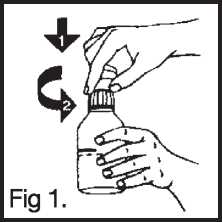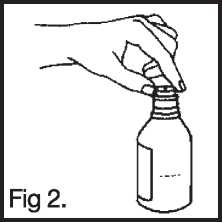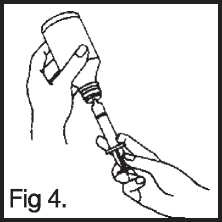Klaricid Paediatric Suspension 250mg/5ml
£ PATIENT INFORMATION LEAFLET
2 ON
O
S KLARKXD PAEDIATRIC SUSPENSION
250MG/5ML
(Clarithromycin)
Read all of this leaflet carefully before you give this medicine to your child because it contains important information.
• Keep this leaflet. You may need to read it again.
• If you have further questions, ask your doctor or your pharmacist.
• This medicine has been prescribed for your child only. Do not pass it on to others. It may harm them, even if their symptoms are the same as your child’s.
• If your child gets any side effects, talk to your doctor or pharmacist. This includes any possible side effects not listed in this leaflet. See Section 4.
What is in this leaflet:
1. What Klaricid Paediatric Suspension 250mg/5ml is and what it is used for
2. What you need to know before giving Klaricid Paediatric Suspension 250mg/5ml
3. How to give Klaricid Paediatric Suspension 250mg/5ml
4. Possible side effects
5. How to store Klaricid Paediatric Suspension 250mg/5ml
6. Content of the pack and other information
1. What Klaricid Paediatric Suspension 250mg/5ml is and what it is used for
Each 5ml spoonful of Klaricid Paediatric Suspension 250mg/5ml contains 250mg of the active ingredient clarithromycin.
Klaricid belongs to a group of medicines called macrolide antibiotics. Antibiotics stop the growth of bacteria (bugs) that cause infections.
It is used to treat infections such as:
1. Chest infections, such as bronchitis and pneumonia
2. Throat and sinus infections
3. Skin and tissue infections
4. Ear infections particularly inflammation of the middle ear (acute otitis media).
Klaricid Paediatric Suspension 250mg/5ml is used in children 6 months to 12 years old.
2. What you need to know before giving Klaricid Paediatric Suspension 250mg/5ml

Do not give Klaricid Paediatric Suspension 250mg/5ml to your child if they;
• are allergic to clarithromycin, other macrolide antibiotics such as erythromycin or azithromycin, or any of the other ingredients of Klaricid Paediatric Suspension 250mg/5ml.
• are taking medicines called ergotamine or dihydroergotamine tablets or use ergotamine inhalers for migraine.
• are taking medicines called terfenadine or astemizole (widely taken for hay fever or allergies) or cisapride (for stomach disorders) or pimozide (for mental health problems) as combining these drugs can sometimes cause serious disturbances in heart rhythm.
• are taking lovastatin or simvastatin (HMG-CoA reductase inhibitors, commonly known as statins, used to lower levels of cholesterol (a type of fat) in the blood).
• have low levels of potassium in the blood (a condition known as hypokalaemia).
• have severe liver disease with kidney disease.
• have an irregular heart rhythm.
• are taking medicines called ticagrelor or ranolazine (for heart attack, chest pain or angina)
• are taking colchicine (usually taken for gout)
Warning and precautions
Talk to your doctor or pharmacist before giving Klaricid Paediatric Suspension 250mg/5ml:
• if your child has any liver or kidney problems
• if your child has, or is prone to, fungal infections (e.g. thrush)
• if your child has been told that they have an intolerance to any sugars as Klaricid Paediatric Suspension 250mg/5ml contains sucrose.
Other medicines and Klaricid paediatric Suspension 250mg/5ml
Tell your doctor if your child is taking any of the following medicines as their dose may need
to be changed or they may need to have regular tests performed:
• digoxin, quinidine or disopyramide (for heart problems)
• warfarin (for thinning the blood)
• carbamazepine, valproate, phenobarbital or phenytoin (for epilepsy)
• atorvastatin, rosuvastatin (HMG-CoA reductase inhibitors, commonly known as statins, and used to lower levels of cholesterol (a type of fat) in the blood). Statins can cause rhabdomyolosis (a condition which causes the breakdown of muscle tissue which can result in kidney damage) and signs of myopathy (muscle pain or muscle weakness) should be monitored.
• nateglinide, pioglitazone, repaglinide, rosiglitazone or insulin (used to lower blood glucose levels)
• theophylline (used in patients with breathing difficulties such as asthma)
• triazolam, alprazolam or midazolam (sedatives)
• cilostazol (for poor circulation)
• omeprazole (for treatment of indigestion and gastric ulcers)
• methylprednisolone (a corticosteroid)
• vinblastine (for treatment of cancer)
• ciclosporin, sirolimus and tacrolimus (immune suppressants)
• etravirine, efavirenz, nevirapine, ritonavir, zidovudine, atazanavir, saquinavir (anti-viral drugs used in the treatment of HIV)
• rifabutin, rifampicin, rifapentine, fluconazole, itraconazole (used in the treatment of certain bacterial infections)
• tolterodine (for overactive bladder)
• verapamil, amlodipine, diltiazem (for high blood pressure)
• sildenafil, vardenafil and tadalafil (for impotence in adult males or for use in pulmonary arterial hypertension (high blood pressure in the blood vessels of the lung))
• St John’s Wort (a herbal product used to treat depression)
• aminoglycosides (a group of antibiotic to treat certain bacteria for example gentamicin, neomycin) and other medicines that may be toxic to the ear.
Klaricid does not interact with oral contraceptives.
Pregnancy and breast-feeding
The safety of Klaricid Paediatric Suspension 250mg/5ml in pregnancy and breast-feeding is not known. As Klaricid Paediatric Suspension 250mg/5ml may be given to girls of childbearing age you should speak to your doctor before giving this medicine if pregnancy is known or suspected.
Driving and Using Machines:
Klaricid Paediatric Suspension may make you feel dizzy or drowsy. If they affect you or your child in this way do not drive, operate machinery or do anything that requires you to be alert.
3. How to give Klaricid Paediatric Suspension 250mg/5ml
Always give Klaricid Paediatric Suspension 250mg/5ml exactly as your doctor has told you. Check with your doctor or pharmacist if you are not sure how the dose has been worked out for your child.
The usual doses of Klaricid Paediatric Suspension 250mg/5ml are given below:
|
Dosage based on body weight | ||
|
Weight (kg) |
Age (years) |
Dosage in mis (twice daily) |
|
8-11 |
1-2 |
1.25 |
|
12-19 |
3-6 |
2.5 |
|
20-29 |
7-9 |
3.75 |
|
30-40 |
10-12 |
5 |
Children who weigh less than 8kg should be given a dose of 0.15 ml/kg twice a day.
Doctors may sometimes prescribe higher or lower doses than these.
Klaricid Paediatric Suspension 250mg/5ml is supplied with a pipette to help you measure
the right amount of medicine to give to your child.
Please follow these instructions carefully;
1. Remove the child-proof cap from the bottle by pushing down on the cap while turning it anticlockwise (Fig 1).
2. Take the plastic circular stopper from the carton and push this into the neck of the bottle. This should fit tightly and once it is in place it should not be removed. (Fig 2).
3. Take the pipette out of the carton and ensure that the plunger is pressed down inside the barrel as far as it will go. This gets rid of any air that may be inside the barrel.
4. Insert the nozzle of the pipette into the hole in the stopper (Fig 3).
5. Turn the bottle upside down. Keep hold of the bottle in one hand and the pipette in the other (Fig 4).
6. Hold the barrel of the pipette steady and slowly, pull the plunger down until you see the liquid fill the barrel to the mark which matches the number of ml that you need to give to your child (Fig 4).
7. Turn the bottle back the right way up.
8. Keeping hold of the barrel, remove the whole pipette from the bottle.
BLACK - Cutting Die
FRONT
20011473_d1
9. The contents of the pipette can be emptied directly into your child’s mouth by pushing down on the plunger while still holding the barrel. Alternatively, empty the measured dose from the pipette onto a spoon for your child to take the medicine from.
10. Replace the cap on the bottle of medicine.
11. Wash the pipette in warm soapy water and rinse well. Hold the pipette under water and move the plunger up and down several times to make sure the inside of the barrel is clean.
Store the pipette in a hygienic place with the medicine.




Klaricid Paediatric Suspension 250mg/5ml should be given twice a day, once in the morning and again in the early evening.
It can be given at mealtimes if this is more convenient.
You should shake the bottle well before using and replace the cap firmly after use. Klaricid Paediatric Suspension 250mg/5ml is usually given for 5 to 10 days.
If you give more Klaricid Paediatric Suspension 250mg/5ml than you should
If you accidentally give your child more Klaricid Paediatric Suspension 250mg/5ml in one day than your doctor has told you to, or if your child accidentally swallows some extra medicine, contact your doctor or nearest hospital emergency department immediately.
An overdose of Klaricid Paediatric Suspension 250mg/5ml is likely to cause vomiting and stomach pains.
If you forget to give Klaricid Paediatric Suspension 250mg/5ml
If you forget to give your child a dose of medicine, give one as soon as you remember.
Do not give more Klaricid Paediatric Suspension 250mg/5ml in one day than your doctor tells you to.
If you stop giving Klaricid Paediatric Suspension 250mg/5ml
Do not stop giving this medicine even if your child feels better. It is important to give the medicine for as long as the doctor has told you to, otherwise the problem might come back.
If you have any further questions on the use of this medicine, ask your doctor or pharmacist.
4. Possible Side Effects
Like all medicines, Klaricid Paediatric Suspension 250mg/5ml can cause side effects although not everybody gets them.
jk
/ * -q\ If your child suffers from any of the following at any time during their
treatment STOP giving the medicine and contact your doctor immediately:
• severe or prolonged diarrhoea, which may have blood or mucus in it. Diarrhoea may occur over two months after treatment with clarithromycin, in which case you should still contact your doctor.
• a rash, difficulty breathing, fainting or swelling of the face and throat. This is a sign that your child may have developed an allergic reaction
• yellowing of the skin (jaundice), skin irritation, pale stools, dark urine, tender abdomen or loss of appetite. These are signs that your child’s liver may not be working properly.
• severe skin reactions such as blistering of the skin, mouth, lips, eyes and genitals (symptoms of a rare allergic reaction called Stevens-Johnson syndrome/toxic epidermal necrolysis).
• muscle pain or weakness known as rhabdomyolysis (a condition which causes the breakdown of muscle tissue which can result in kidney damage).
Common side effects of Klaricid Paediatric Suspension 250mg/5ml include;
• headache
• difficulty sleeping
• changes in sense of taste
• stomach problems such as feeling sick, vomiting, stomach pain, indigestion, diarrhoea
• a change in the way the liver works
• skin rash
• increased sweating
Other less common side effects include:
• high temperature
• swelling, redness or itchiness of the skin.
• acne
• oral or vaginal ‘thrush’ (a fungal infection)
• reduction in the level of certain blood cells (which can make infections more likely or increase the risk of bruising or bleeding)
• loss of appetite, heartburn, bloating, constipation, wind
• inflammation of the pancreas
• anxiety, nervousness, drowsiness, tiredness, dizziness, tremor or shaking
• confusion, loss of bearings, hallucinations (seeing things), change in sense of reality or panicking, depression, abnormal dreams or nightmares
• convulsion (fits)
• ringing in the ears or hearing loss
• vertigo
• paraesthesia, more commonly known as ‘pins and needles’
• leaking of blood from blood vessels (haemorrhage)
• inflammation of the mouth or tongue
• discolouration of the tongue or teeth
• dry mouth
• loss of taste or smell or inability to smell properly
• joint pain
• muscle spasms, muscle pain or loss of muscle tissue. If your child suffers from myasthenia gravis (a condition in which the muscles become weak and tire easily) or rhabdomyolysis (a condition which causes the breakdown of muscle tissue), clarithromycin may worsen these symptoms
• chest pain or changes in heart rhythm such as palpitations
• a change in the levels of products made by the liver, inflammation of the liver or an inability of the liver to function properly (you may notice yellowing of the skin, dark urine, pale stools or itchiness of the skin)
• a change in the levels of products produced by the kidney, inflammation of the kidney or an inability of the kidney to function properly (you may notice tiredness, swelling or puffiness in the face, abdomen, thighs or ankles or problems with urination)
• a change in the levels of certain cells or products found in the blood.
Reporting side effects
If you get any side effects, talk to your doctor or pharmacist. This includes any possible side effects not listed in this leaflet.
5. How to store Klaricid Paediatric Suspension 250mg/5ml

Keep this medicine out of the sight and reach of children
Do not use this medicine after its use-by (exp.) date that is printed on the label. Keep this medicine in a cool place. Do not store above 30°C. Do not refrigerate or freeze.
Klaricid Paediatric Suspension 250mg/5ml must be used within 14 days of you receiving the bottle from the pharmacist.
Do not throw away any medicines via wastewater or household water. Ask your pharmacist how to throw away medicines you no longer use. These measures will help protect the environment.
6. Content of pack and other Information
What Klaricid Paediatric Suspension 250mg/5ml contains
Each 5ml spoonful of Klaricid Paediatric Suspension 250mg/5ml contains 250 mg of the active ingredient clarithromycin.
Other ingredients are: sucrose, carbopol 974P, povidone K90, hydroxypropylmethylcellulose phthalate, castor oil, silicon dioxide, xanthan gum, fruit punch flavour, potassium sorbate, citric acid, maltodextrin, titanium dioxide and water.
What Klaricid Paediatric Suspension 250mg/5ml looks like and contents of the pack
Klaricid Paediatric Suspension 250mg/5ml is an off-white colour and is available in bottles of 70 ml. Not all pack sizes may be marketed.
Marketing Authorisation Holder and Manufacturer:
Marketing Authorisation Holder - Mylan Products Ltd., 20 Station Close, Potters Bar,
Herts, EN61TL, UK
Manufacturer - AbbVie S.r.l
S.R 148 Pontina KM 52 SNC
04011 Campoverde di Aprilia (LT)
Italy
This leaflet was last revised in June 2016
M Mylan
20011473
BLACK - Cutting Die
BACK
20011473_d1